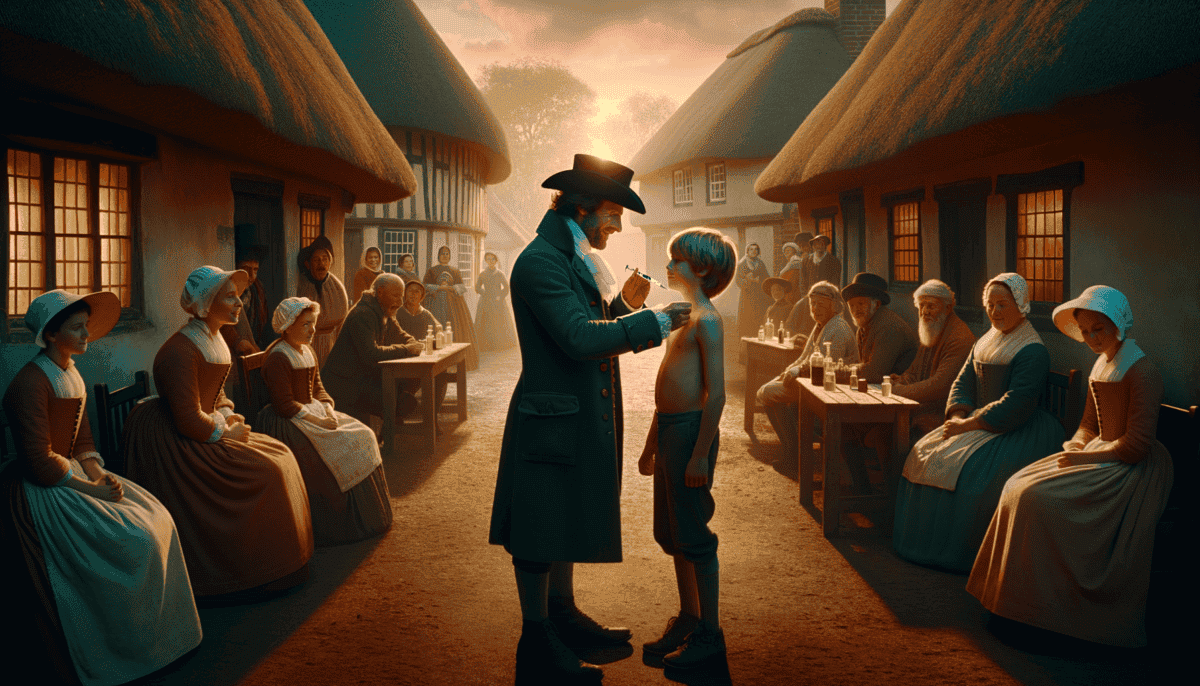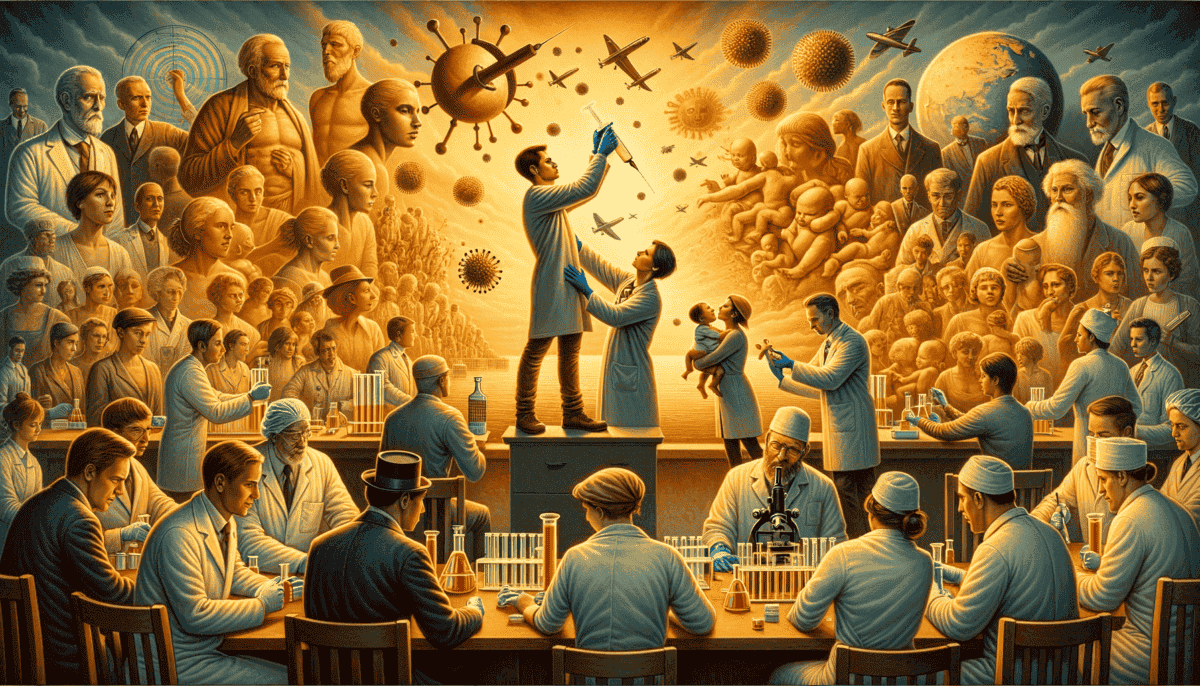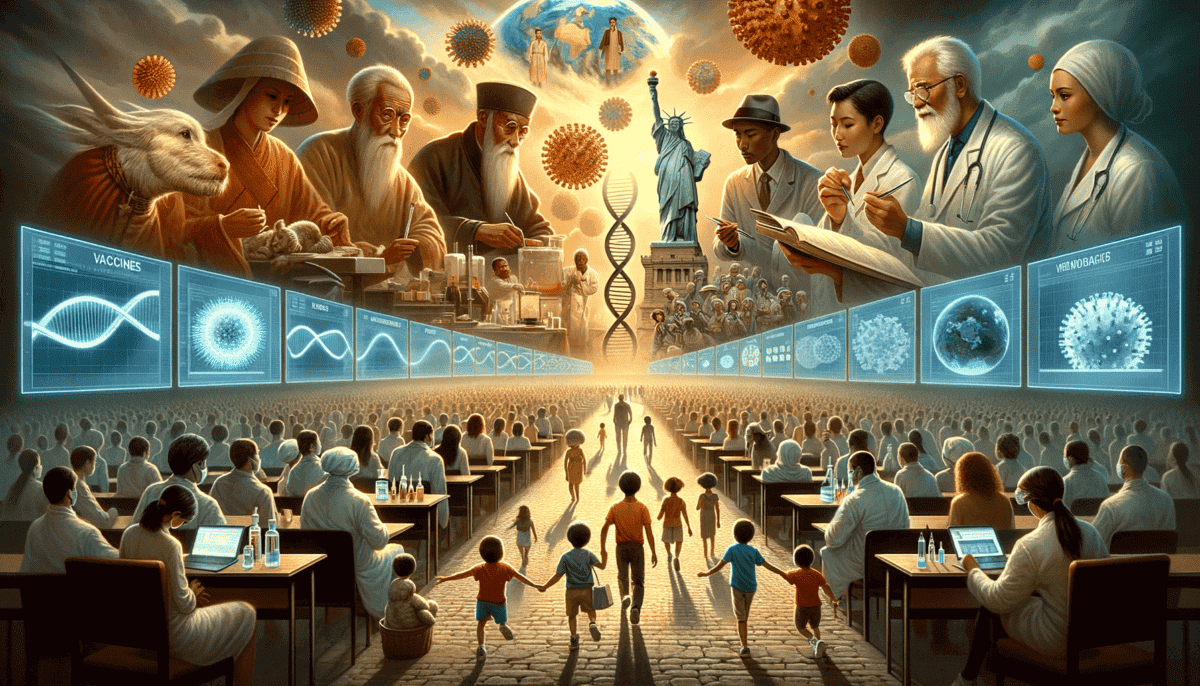The Hidden Enemies
Dr. Sarah Chen smiled at her young daughter Emma as they walked into the Science Museum. "Today, we're going to learn about something amazing that keeps us healthy!"
Emma's eyes widened with curiosity. "What is it, Mommy?"
"We're going to learn about tiny things called germs. They're so small we can't see them without special tools!"
The museum's first display showed a giant model of different germs. Some looked like tiny balls, others like squiggly worms. Emma pressed her nose against the glass.
"Yuck! Are these real?" she asked.
"These are just models," Dr. Chen explained. "The real ones are much, much smaller. Think about this – if a germ was the size of an ant, you would be as tall as a mountain!"
Fun Fact: People didn’t always know about germs. Long ago, they thought sickness came from bad smells or evil spirits!
They walked to the next display, which showed pictures from ancient China and India. Dr. Chen pointed to an old drawing of people putting powder in their noses.
"Look at this, Emma. A very long time ago, people in China found a clever way to fight smallpox – a very bad disease. They would take a tiny bit of the disease and put it in healthy people's noses. This helped their bodies learn to fight the disease!"
Emma wrinkled her nose. "That sounds weird!"
"It does sound strange," Dr. Chen laughed. "But it was the first step in learning how to protect people from getting sick."
The First Disease Fighters
They stopped at a display showing ancient healers at work. Emma saw people grinding herbs and making medicines.
"In India," Dr. Chen explained, "healers wrote books about how to stop diseases from spreading. They knew that sick people should stay away from healthy people."
"Just like when Tommy had to stay home with chicken pox!" Emma exclaimed.
"Exactly! Even though they couldn't see germs, these early healers were very smart. They watched carefully and learned how diseases moved from person to person."
• Using special herbs as medicine
• Keeping sick people separate from others
• Cleaning wounds with honey
• Teaching people to stay clean
As they reached the end of the exhibit, Emma tugged on her mother's sleeve. "But Mommy, if germs are so tiny, how do doctors fight them now?"
Dr. Chen's eyes sparkled. "That's a great question! Let me tell you about some amazing scientists who changed everything. It all started with a doctor named Edward Jenner…"
The story continues as they move toward the next exhibit, where new discoveries await them in their journey through the history of fighting disease.
Life Lessons from Tiny Teachers
On their way to the next display, Emma stopped to look at a giant microscope model. "Can I see real germs someday?"
"Of course! At my laboratory, we use special microscopes that make tiny things look huge. Maybe next week you can visit and see for yourself!"
Emma bounced excitedly. "Will I get to wear a white coat like you?"
"We'll even get you your own small lab coat," Dr. Chen promised. "Because who knows? Maybe someday you'll help discover new ways to keep people healthy too!"
A Doctor’s Bold Idea
Emma and Dr. Chen walked into a new room at the museum. A large painting showed a kind-faced man wearing old-fashioned clothes. ⚕️
“This is Dr. Edward Jenner,” Dr. Chen explained. “He lived in England about 200 years ago, when a scary disease called smallpox was making many people very sick.”
Emma looked at pictures showing people with spots all over their faces. “That looks awful!”
“It was,” Dr. Chen nodded. “But Dr. Jenner noticed something interesting about milkmaids – the women who milked cows.”
Important Discovery! Milkmaids who got a mild illness called cowpox didn’t get the dangerous smallpox disease.
Emma’s eyes grew wide. “The cows helped keep people healthy?”
“In a way, yes! Dr. Jenner had a brave idea. He thought if he gave people a tiny bit of cowpox, it might protect them from getting smallpox.”
The First Vaccine Test
Dr. Chen pointed to another picture showing a young boy named James Phipps. “This was Dr. Jenner’s first test. He put a tiny scratch on James’s arm with some cowpox from a milkmaid named Sarah Nelmes.”
“Wasn’t that scary?” Emma asked.
“It was very brave of James,” Dr. Chen agreed. “But guess what? It worked! James got a little sick from the cowpox, but when he was later exposed to smallpox, he didn’t get sick at all!”
“This was the world’s first vaccine. The word ‘vaccine’ comes from ‘vacca’ – the Latin word for cow!”
Spreading the Good News
The next display showed ships sailing across oceans. “Dr. Jenner shared his discovery with doctors around the world,” Dr. Chen explained. “Soon, people everywhere were getting protected from smallpox.”
“Even kings and queens got vaccinated!” Emma read from a sign.
“That’s right! And do you know what’s really amazing? Because of vaccines, smallpox doesn’t make people sick anymore. It’s completely gone from the world!”
• Save millions of lives
• Show how to fight other diseases
• Change medicine forever
• Protect people all over the world
Emma looked thoughtful. “Dr. Jenner must have been really smart to figure that out.”
“He was smart, but he was also very patient and careful,” Dr. Chen said. “He watched, asked questions, and wasn’t afraid to try new ideas.”
A Legacy of Hope
“After Dr. Jenner’s discovery, other scientists began looking for more ways to protect people from diseases,” Dr. Chen continued. “One of them was a man named Louis Pasteur…”
Emma tugged her mother toward the next exhibit. “Tell me about him! Did he make vaccines too?”
Dr. Chen smiled as they walked on. “He sure did! And his story is just as exciting…”
The Curious Scientist
Dr. Chen led Emma to a new display showing a busy laboratory. A man with a white beard bent over glass bottles filled with colorful liquids.
“This is Louis Pasteur,” Dr. Chen said. “He loved solving puzzles about tiny germs we can’t see with our eyes.”
A Mystery in the Lab
Emma peered at the old photographs. “What’s he doing with all those bottles?”
“Pasteur was trying to help sick farm animals,” Dr. Chen explained. “Many chickens were getting very ill from a disease called chicken cholera.”
Fun Fact! Pasteur made a surprising discovery when he forgot about some germs in his lab!
“One day, Pasteur went on vacation and left some germs in bottles,” Dr. Chen continued. “When he came back, the germs had gotten old and weak.”
“Did that ruin his work?” Emma asked.
A Lucky Accident
“Actually, it led to something amazing! When he gave these weak germs to chickens, they only got a little sick. Later, when the same chickens met strong germs, they didn’t get sick at all!”
“Sometimes the best discoveries happen by accident! The weak germs taught the chickens’ bodies how to fight off the strong ones.”
Saving People from Rabies
Dr. Chen pointed to another picture showing a young boy. “This is Joseph Meister. He was bitten by a dog that had a scary disease called rabies.”
“That sounds scary!” Emma said.
“It was very scary. But Pasteur had been working on a special medicine – a vaccine for rabies. He gave it to Joseph, and it saved his life!”
• How germs make us sick
• How to make vaccines safer
• Ways to protect both animals and people
• How to keep food fresh longer
Making Food Safe
“Pasteur didn’t just make vaccines,” Dr. Chen said. “He also found a way to make milk safer to drink. We call it pasteurization, named after him!”
“Is that why my mom always tells me to drink pasteurized milk?” Emma asked.
“Exactly! He helped make lots of foods safer to eat and drink.”
A Growing Understanding
“Pasteur showed us that we could make vaccines for many different diseases,” Dr. Chen explained. “His work helped other scientists make new vaccines too.”
Emma looked excited. “What other diseases did people learn to stop?”
“Well, one of the biggest challenges was a disease called polio. It was especially hard on children…”
Emma leaned forward eagerly. “What happened with polio? Did they make a vaccine for that too?”
The Race Against Polio
Emma’s eyes widened as Dr. Chen showed her pictures of children in large metal tubes. “What are those?” she asked.
“Those are iron lungs,” Dr. Chen explained gently. “Many children with polio needed them to breathe. In the 1950s, polio scared everyone, especially parents.”
Two Heroes Rise
Dr. Chen pointed to photos of two men in white coats. “These are Dr. Jonas Salk and Dr. Albert Sabin. They both wanted to stop polio from hurting children.”
Important Discovery! Dr. Salk worked day and night in his laboratory to create the first polio vaccine that could be given as a shot.
“Did kids like getting shots?” Emma wrinkled her nose.
“Not much,” Dr. Chen smiled. “But Dr. Sabin had another idea. He made a vaccine that children could take as sweet drops on their tongue!”
Testing the Vaccine
“Dr. Salk was so sure his vaccine was safe, he gave it to his own children first,” Dr. Chen said. “Then many brave children helped test it.”
“These children were called ‘Polio Pioneers.’ They were real heroes who helped protect millions of other kids!”
The World Joins Together
“Soon, children everywhere started getting their polio vaccines,” Dr. Chen continued. “People in different countries worked together to share the vaccine.”
• Schools held vaccine drives
• Doctors traveled to far places
• Communities spread the word
• Parents brought their children
• Scientists kept making better vaccines
A World of Change
“Before the vaccine, polio hurt thousands of children every year,” Dr. Chen explained. “But after the vaccine, fewer and fewer children got sick.”
“Did polio go away completely?” Emma asked hopefully.
“Almost! Today, polio is gone from most countries. But scientists are still working hard to protect everyone.”
Lessons Learned
“The fight against polio taught us something very important,” Dr. Chen said. “When people work together, we can do amazing things!”
Emma looked thoughtful. “Like how scientists today make new vaccines?”
“Exactly! And speaking of new vaccines, wait until you see how scientists make them today…”
Emma bounced excitedly. “Do they use computers and robots?”
The Future of Fighting Disease
Emma’s eyes sparkled as Dr. Chen led her into a modern laboratory. “Wow! It looks like a spaceship in here!” she exclaimed.
“Today’s labs are very different from Dr. Jenner’s time,” Dr. Chen smiled. “We use amazing new tools to make vaccines.”
Super Smart Science
“Look at this computer screen,” Dr. Chen pointed. “Scientists can now see tiny germs in 3D! It’s like having super-powerful eyes.”
Cool Fact: Modern scientists use special computers to design vaccines faster than ever before!
“But how do they make the vaccines?” Emma asked curiously.
“Well, remember how Dr. Jenner used cowpox to fight smallpox? Today we have many clever ways to make vaccines safe and strong.”
The COVID-19 Story
“When COVID-19 came, scientists around the world worked together like never before,” Dr. Chen explained. “They shared their ideas through computers.”
“Scientists made new types of vaccines in less than a year – that’s super fast! Usually, it takes much longer.”
Emma looked impressed. “Did they use robots too?”
“Yes! Special robots help test thousands of different vaccine ideas at once. It’s like having a thousand tiny laboratories working at the same time!”
Working Together Around the World
Dr. Chen showed Emma a big world map on the wall. “See all these glowing dots? Each one is a laboratory where scientists work together.”
• Super-powerful microscopes
• Smart computers
• Helper robots
• Special freezers
• Fast testing machines
New Challenges, New Solutions
“But there are still many diseases we need to fight,” Dr. Chen said. “Scientists are working on vaccines for cancer and allergies too!”
“Really? Vaccines can help with those?” Emma asked excitedly.
“We hope so! Scientists are trying new ideas every day.”
The Next Generation
“Some vaccines now don’t even need shots,” Dr. Chen explained. “Scientists are making vaccines you can breathe in or wear like a patch!”
Emma touched her arm where she got her last vaccine. “That sounds much better than shots!”
“The future of vaccines is very exciting,” Dr. Chen smiled. “Maybe someday you’ll be a scientist too, helping to protect people from diseases.”
Emma stood up straighter. “I think I’d like that. We could help lots of people stay healthy!”
“That’s right! And there’s still one more important thing to learn about vaccines…”
Protecting Our Future Together
“Dr. Chen, what’s the most important thing about vaccines?” Emma asked eagerly. Her notebook was almost full of drawings and notes from their amazing journey through vaccine history.
“The most amazing thing,” Dr. Chen smiled warmly, “is how vaccines help everyone protect each other.”
A Shield for Everyone
“Think of vaccines like a huge umbrella,” Dr. Chen explained, spreading her arms wide. “When many people get vaccinated, we create something special called ‘community protection.'” ☂️
Amazing Fact: When most people get vaccines, they help protect babies and sick people who can’t get vaccines themselves!
“Like a team working together?” Emma asked.
“Exactly! Just like all the scientists who worked together through history.”
The Big Victory
“Remember smallpox? The scary disease Dr. Jenner fought?” Dr. Chen asked. Emma nodded.
“Thanks to vaccines, smallpox is gone forever! It’s the first disease humans have completely stopped!”
“Wow! Could we do that with other diseases too?” Emma’s eyes lit up.
“We’re trying! Scientists are close to stopping polio forever. Many other diseases are becoming rare too!”
Looking to Tomorrow
Dr. Chen pulled out a shiny tablet. “Look at these new ideas scientists are working on:”
• Vaccines that don’t need to be cold
• One shot that protects against many diseases
• Vaccines that taste like candy
• Patches instead of shots
• Vaccines that work better for everyone
Emma’s Big Decision
“I’ve decided,” Emma announced proudly. “I want to be a vaccine scientist when I grow up!”
Dr. Chen beamed. “That’s wonderful! The world always needs more heroes like Jenner, Pasteur, and Salk.”
“And maybe I’ll discover something new, just like they did!” Emma said excitedly.
“I bet you will,” Dr. Chen agreed. “The story of vaccines isn’t over. There are still many exciting chapters to write!” ✨
A Bright Tomorrow
As Emma packed up her notebook, she thought about everything she’d learned. From cowpox to computers, from scary diseases to amazing cures, vaccines had changed the world.
“Thank you for teaching me about vaccines, Dr. Chen,” Emma said. “Now I know they’re not scary – they’re super cool!”
“Remember Emma,” Dr. Chen said softly, “every time someone gets a vaccine, they’re helping to write the next chapter in this amazing story. And now you’re part of that story too.”
Emma walked out of the laboratory with her head held high, ready to share what she’d learned with everyone she knew. She couldn’t wait to see what new discoveries tomorrow would bring!






